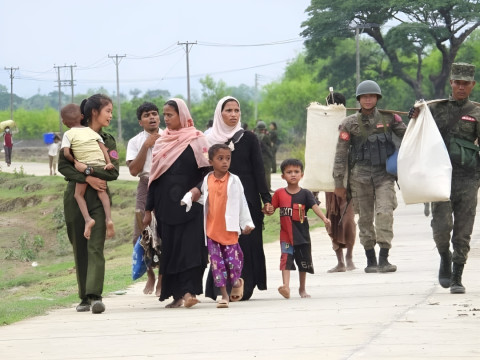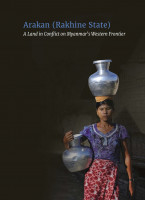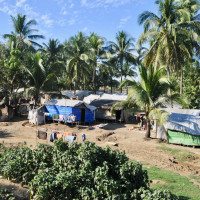Buthidaung is the first Rohingya-majority town to be captured by the AA and the tenth on the Arakan military front. At the same time, Buthidaung township – with its population swollen by displaced people escaping the fighting – probably hosted the largest concentration of SAC military installations in Rakhine State, including Military Operations Command 15 and more than 11 military battalions under its control. However even before the town’s capture on 17 May, the majority of the houses owned by Rakhine, Khami, Hindu and other non-Muslim families had reportedly been burnt down, with claims as high as 5,000 in number and allegedly by ARSA and Muslim troops trained by the Myanmar military. Conflict tensions were rising.
The communal dimensions then reached an even more challenging and controversial phase when Rohingya houses were burnt down during the night of 17 May when AA troops attempted to capture the town. Since this time, two polarized narratives have developed regarding this incident, reflecting the divides in Arakan politics and society today.
The first opinion is represented by the ULA/AA’s position that they initiated precautions and issued early warnings before their offensive on the town and that the burning of Rohingya houses was the result of deliberate and prolonged aerial attacks by the Myanmar military as well as arson by the armed Rohingya groups on their retreat. The razing of homes has long been a standard tactic of the Myanmar military in ‘regional clearance’ operations against opposition groups across the country. In his latest comment on 3 June 2024, the ULA/AA leader Maj-Gen. Twan Mrat Naing explained that the early warnings were performed by the Muslim officers of the ULA administration. Regarding the burning of civilian houses, he added that at least 2,322 houses of non-Rohingya had already burnt down before the capture of the town by the AA on 17 May and subsequently around 500 Rohingya houses were destroyed due to the fighting.
In contrast, the second position described in a statement by a number of Rohingya diaspora groups is that the AA attacked the town before the deadline to leave and that, during the fighting, AA members looted the houses of Rohingya residents before setting them on fire. In addition, the diaspora statement listed other allegations of human rights violations by the AA, including forced recruitment, human shields, mass killings, and arson attacks, which the ULA/AA has denied. In addition, it should be noted that various domestic and external actors, including UN agencies, foreign embassies, inter-governmental organisations (IGOs), and international and domestic non-governmental organisations (NGOs), also quickly issued statements about the crisis in Buthidaung.
For the moment, it is difficult to assess all the details and different validity. Establishing culpability for the loss of civilian lives, homes and property in urban contexts where there may be several conflict actors presents many challenges. But, in an initial reading between the lines of these statements, it can be interpreted that positions taken by the foreign embassies, especially those of the USA and Europe, are mostly constructive and diplomatic in seeking to understand the complexities of unfolding events, whereas those released by the UN, IGOs and NGOs are more assertive and authoritative in presenting what they believe has taken place as factual. Clearly, much greater understanding and investigation are needed in one of the most complex conflict frontlines in the world, and this needs transparent, unrestricted and independent access under international human rights norms.
Further compounding the crisis, internet and phone communication blackouts are adding to the complexities in assessing accusations and addressing urgent issues as they unfold. Indeed, the complications are so grave that international observers have warned about the possibility of an outbreak of another round of communal violence such as Arakan experienced in 1942 and 2012. This was highlighted by an International Crisis Group report on 10 May. But while timely, reports such as this are until now lacking sufficient contextual analysis about the situation in the conflict frontline. Around 80 percent of the local population lack internet access, allegations and counter-allegations are rife, and conflicting remarks on social media platforms are hardly tangible enough to make concrete conclusions. In particular, it is vital that there is cohesion in investigation and reporting in ethno-political contexts like north Arakan and the Bangladesh borders where communal tensions can quickly be inflamed.
For the moment, taking a more positive view, it can be argued that another outbreak of communal violence is less likely during the present crisis based upon four key factors. First, as explored in a previous TNI commentary, the nature of ‘Rakhine ethno-nationalism’ has been changing over recent decades from the dark side – i.e. dislike and aggression toward ethnic Bamar and Rohingya communities as reflected in discrimination against non-Rakhine minorities – towards the bright side – i.e. political motivation and consciousness among the Rakhine population in demanding and struggling for the right to self-determination and sovereignty for all the peoples of Arakan. Such sentiments are especially marked among the political elite and middle class.
Second the ULA leadership, who possess the political concepts of authority (‘ana’) and influence (‘awza’) at the present stage in Myanmar’s transitional crisis, do not want or support the outbreak of communal violence in Arakan. In addition to the protection of human rights values, it would be morally and practically harmful to their image and interests. Under any future scenario, if communal violence breaks out, relations between the Rakhine and Rohingya communities will result in a deeply-polarized schism in which acting as a neutral authority becomes even more difficult. If the ULA authorities are seen as only protecting the Rakhine population against the Rohingya, it will be harmful to trust-building among Arakan’s peoples and in achieving international acceptance. At the same time, if the actions of the ULA are perceived as protecting only Rohingya communities over Rakhine, this would similarly result in a reduction in the group’s popularity and support. In summary, the ULA leadership has both moral and strategic interests to prevent communal violence from breaking out.
Third, social awareness and consciousness can also prevent members of both Rakhine and Rohingya communities from starting communal violence. This is a tangible result of the social cohesion efforts by the ULA leadership and other non-state and civil society actors during recent years. In Arakan today it is common sense that violence between the two communities would result in mutual destruction that could only be beneficial to the common aggressor, the Myanmar military and SAC authorities in the territory. People from all nationalities are aware that this is a divisive scenario that Snr-Gen. Min Aung Hlaing and the ruling generals are seeking to work towards. The reported massacre of over 50 villagers suspected of supporting the ULA/AA by the Myanmar military near Sittwe in late May warn that the dangers are very real.
Finally, as the fourth factor, there is also the international perspective. Unlike in 1942 and 2012, both regional and international observers and stakeholders are now well aware of the situation. As Myanmar’s tragedy continues, their precautions and warnings are positively contributing to hindering the outbreak of communal violence. A struggle for freedom is underway not only in Arakan, and young people especially are determined to end military rule and move away from Myanmar’s troubled past.
There is, however, no room for complacency, and there are still other potential ‘X factors’ that we cannot yet fully understand or determine how they will unfold in the coming days and weeks. It is critical to be always aware of how the SAC authorities, as their control diminishes, can still try different methods to instigate communal violence. The recent activities of the junta-backed ARSA, ARA, RSO and other armed Rohingya men are evidence of this divisive enterprise. A more politically complex scenario now appears to be emerging over the Maungdaw and Buthidaung areas.
At the same time, many people in Arakan find it worrisome how the Bangladesh authorities have been backing the RSO in helping its forced recruitment of more Rohingya youths – apparently to fight against the AA on the Arakan front. For the moment, it is important to note that the May policy statement by the diaspora Rohingya groups states that none of the RSO, ARSA or ARA represent the Rohingya community. Most recently, raising concerns further, AFP reported on 30 May that a teacher and student had been killed by gunmen in the main Kutupalong refugee camp for refusing to join the RSO.
Nevertheless, it is still critical to wait a little while longer and see to what extent Dhaka government policy influences the ordinary Rohingya population inside both Rakhine State and refugee camps across the Bangladesh border. Unpredictable times remain ahead and, after six months of intensive fighting, the local populations from all communities are facing an increasing burden of humanitarian suffering and emergency. Inter-community peace-building – not the provocation of more conflict – are urgently required.






